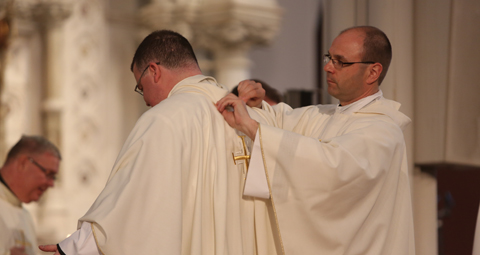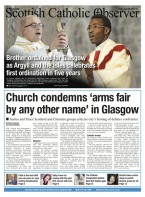June 22 | ![]() 0 COMMENTS
0 COMMENTS ![]() print
print

Collapsing buildings brings us up to speed with our inner structure
THE BOW IN THE HEAVENS Warns of iconic buildings and the maintenance that goes with all things living — By FR JOHN BOLLAN
Like many people, I woke on Saturday morning to the news that the Glasgow School of Art had been ravaged by fire for the second time in four years. It was especially tragic, given that the extensive restorations after the last fire were nearing completion. In fact, as I rubbed the sleep from my eyes, I thought I had hit the wrong button on my phone and it had summoned this story, accompanied by photographs of flames and fire engines, from the archive. Alas no, however: it was only too real and present.
Despite the fact I don’t have any personal connection with this Mackintosh masterpiece (although I do know people who have studied there), I did have something of that punched-in-the-guts feeling experienced by those who had watched part of their history go up in flames yet again. It’s strange how iconic buildings can have that effect on us.
When the Basilica of St Paul outside the walls – my favourite of the four Patriarchal Basilicas – burned down in July 1823, they decided to keep the news from Pope Pius VII. He was bedridden after a fall and they were afraid that this blow would finish him off. As it transpired, he died the next month. As a young Benedictine monk, he had taught and briefly resided at the monastery at St Paul’s, so his connection with the church was deeply felt.
The only part of the Basilica spared by the flames was the apse, containing some of the most beautiful mosaics in Rome. A decision was taken by the new Pope, Leo XII, to rebuild it to the last detail. Thanks to that decision, the modern visitor would never know of the sorry tale of devastation which gave rise, phoenix-like, to the church we see today.
I hope the Glasgow School of Art can be saved. Even if it is no longer possible to maintain the original shell, it would be a statement of determination and fidelity to the past to rebuild it from scratch, according to Charles Rennie Mackintosh’s original blueprints. After all, surely every plan drawn up by an architect is an implicit template for another such building?
Of course, there are times when it is good to leave a thing in ruins. The bombed-out remnants of Coventry Cathedral witness to the destructive forces of war and the idea that peace itself is a construct, something we have to build, bit by bit.
The maintenance of buildings is, rightly or wrongly, part of the remit of a parish priest. Here in this Diocese at least, attempts are being made to lighten this burden and allow priests to focus more on the spiritual and pastoral ‘bits’ of their day job. I remember one of my former parish priests bemoaning the carefree days of a curacy. ‘When you’re a curate and you’re walking round the grounds saying your breviary, if you happen upon a brick or a bit of tile in your path, you just kick it out of the way. If you’re a parish priest, you look up and wonder ‘Where did that come from?’
St Joseph’s is getting a bit crumbly (a bit like me, as I rapidly approach my fifth decade of life’s Rosary). Built of unfaced brick, rather than stone, it is beginning to show its age. Opened six years after parish was founded in 1947, the church was a labour of love and constructed with the best materials available during this period of post-war austerity. Now, however, the bricks are beginning to crack and flake, and the roof is opening up points of water ingress as quickly as we (or Raymond and his magic ladder) can seal them.
Still, this church ‘built with the pennies of the poor’ is maintained by the pounds of their descendants, so we are more fortunate than some parishes.
Natural erosion is one thing: man-made destruction is another challenge altogether. The other night we had someone smash one of the ceramic planters outside the church, overturn one of the benches at the side door and – most injurious of all – bash the passenger door of my car. Sadly, the CCTV footage is unclear: you can just make out a shadow creeping along the wall before getting up to mischief. Typically, this happened on the one night I had left my car in front of the house instead of the carport.
I had recourse to CCTV footage once again on Sunday, this time to see who had deposited three black traffic cones (roped together) at the side of the church. We use traffic cones to block off spaces for visitors or for funeral vehicles, so it’s not as those these new arrivals are unwelcome additions to our existing supply. But what made me especially curious is that each cone has ‘St Joseph’s Church: The Bow in the Heavens’ emblazoned on it.
Was this, perhaps, a somewhat left-field advertising campaign by the Scottish Catholic Observer? Would enhanced CCTV footage reveal the editor shiftily depositing said cones? Here too, the images provided by the cameras aren’t a great help (perhaps we should get some better cameras – or clean the ones we have). I am genuinely intrigued, however, as to the provenance of the cones and the bizarre sponsorship. If anyone has any answers, I’d be only too glad to hear them.
All of the above serves to illustrate the answer I gave to the question put to me most frequently during the ‘World of Work’ week at the primary school. The kids were having a week of visits from people to tell them about their jobs (Clyde 1 DJ George Bowie, a local boy made good, even gave them a go on the decks) and I was invited to be a part of a ‘speed dating’ session on the Friday afternoon. I’m sure this was part of an awareness raising exercise, rather than a recruitment event, but I still felt a little out of place.
There were about ten of us seated at desks dotted around the Hall. The children had 2 or 3 minutes to ask us about our ‘jobs’ before a buzzer sounded, sending them on to the next visitor. I was a bit crushed to see their faces fall slightly when they entered the Hall to see Father John sitting there – and fall further when the teacher broke the news that they had to start with me.
It was horribly reminiscent of the time I had inadvertently attended a real speed dating event, having misread directions to a community council meeting. I received much the same looks from the kids on Friday afternoon. Part of the problem was overfamiliarity: while some of these visitors were new and exotic, the children know me fairly well. And I didn’t have any ‘fancy’ stuff to show them. I did manage to convince some of the more gullible infants into believing that the ‘business’ cards I gave them were actually special tickets which would get them into the church for free. A few of the parents were less than impressed, I have to say. But my rejoinder was that if they actually brought their kids to Mass on a Sunday, I wouldn’t have to lie to them on a Friday.
To return to the most ‘frequently asked question’: what is it like being a priest? To this question I was able to reply, with all sincerity, that no two days are the same. You are dealing with people, I told them, and everybody is different. Their lives are different, and so are their needs. You just have to do your best to listen, to love them and help in whatever way you can.
‘And how much do you get paid for that?’ was the usual follow-on. The savvier P7s looked a little incredulous as I shared details of my tax return with them. ‘Is that all?’, they asked. ‘Yes, I’m afraid so’, I replied. ‘But you get a house and Pringles and free Wi-Fi’, I added, a little desperately. There was a slight flicker of interest at the Pringles, but all Wi-Fi is free when you’re a kid.
I should have mentioned the magically appearing cones: I’m sure that would have swung it.











